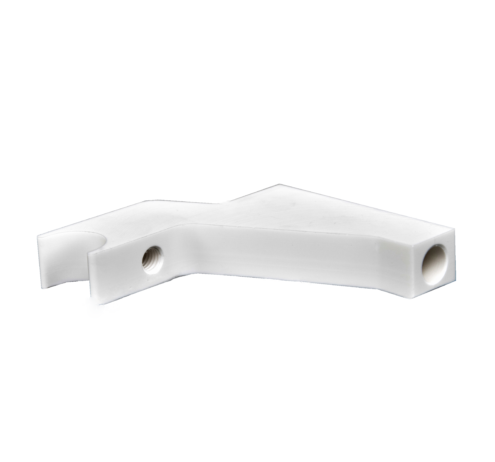PBT Unfilled

PBT Unfilled Overview
What is the Material: PBT Unfilled is a semi-crystalline material.
Key Material Features: This material is beneficial in applications requiring impact resistance, chemicals resistance, wear resistance, low coefficient of friction, and low moisture absorption.
Other Considerations: This material has higher impact resistance than PET.
Physical
| Property | Value | Typical ASTM Test |
|---|---|---|
| Chemical Designation | (PBT) Polybutylene Terephthalate | |
| Trade Names (®, ™) | Hydex 4101 PBT | |
| Color | White, Black | |
| Density (g/cm^3) | 1.31 | D 792 |
Mechanical
| Property | Value | Typical ASTM Test |
|---|---|---|
| Modulus of Elasticity (Tensile Test) (psi) | 430000 | D 638 |
| Tensile Strength at Yield (psi) | 9400 | D 638 |
| Elongation at Yield (%) | 6 | D 638 |
| Elongation at Break (%) | 50 | D 638 |
| Flexural Strength (psi) | 13000 | D 790 |
| Modulus of Elasticity (Flexural Test) (psi) | 430000 | D 790 |
| Compression Strength: 10% Strain (psi) | 11500 | D 695 |
| Compression Strength: 1% Strain (psi) | 2800 | D 695 |
| Compression Modulus (psi) | 315000 | D 695 |
| Impact Strength (Izod) (ft-lbs/in) | 0.7 | D 256 |
| Hardness (M) | 80 | D 785 |
| Coefficient of Friction (Kinetic, 40 psi, 50 fpm) | 0.25 | D 3702 |
| Coefficient of Friction (Static) | 0.19 | D 3702 |
| Wear (K) Factor (in^3-min/ft-lbs-hr) (Against Steel, 40 psi, 50 fpm) | 2.10E-8 | D 3702 |
Thermal
| Property | Value | Typical ASTM Test |
|---|---|---|
| Melting Point (°F) | 430 | D 3418 |
| Deflection Temperature (°F) (66 psi) | 310 | D 648 |
| Deflection Temperature (°F) (264 psi) | 200 | D 648 |
| Service Temperature Continuous (°F) | 221 | |
| Service Temperature Minimal (°F) | -29 | |
| Thermal Expansion (CLTE) (in/in/°F) | 6.10E-5 | D 696 |
Electrical
| Property | Value | Typical ASTM Test |
|---|---|---|
| Specific Surface Resistance (Ω/square) | 1.00E13 | D 257 |
| Dielectric Strength (V/mil) | 400 | D 149 |
| Dielectric Constant (1MHz) | 3 | D 150 |
Other
| Property | Value | Typical ASTM Test |
|---|---|---|
| Moisture Absorption (%) (24 Hours) | 0.02 | D 570 |
| Moisture Absorption (%) (Saturated) | 0.25 | D 570 |
| Flammability | HB |
The data stated are typical values intended for reference and comparison purposes only. The data should not be used as a basis for design specifications or quality control. The information is provided as a guide to the best of our knowledge and given without obligation or liability. Testing under individual application circumstances is recommended.
